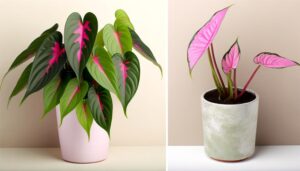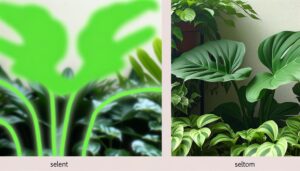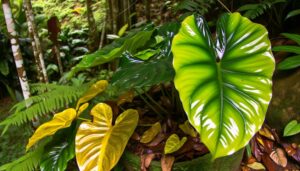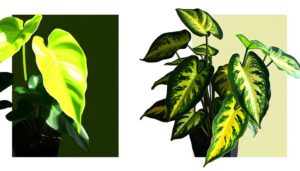Philodendron Little Hope Vs Xanadu: A Comprehensive Guide!
Philodendron Little Hope and Philodendron Xanadu both belong to the Araceae family but differ significantly. Little Hope is characterized by compact, lobed leaves, and a bush-like growth pattern, making it ideal for smaller spaces.
Conversely, Xanadu exhibits broader, deeply dissected foliage and a wider spread, suitable for larger areas. Little Hope has vibrant, glossy green leaves, while Xanadu’s foliage is darker and matte.
Differences extend to their root systems; Little Hope has fibrous roots, whereas Xanadu features rhizomatous roots. These unique characteristics influence their care requirements and suitability for different environments.
Explore further to understand their distinct horticultural adaptations.
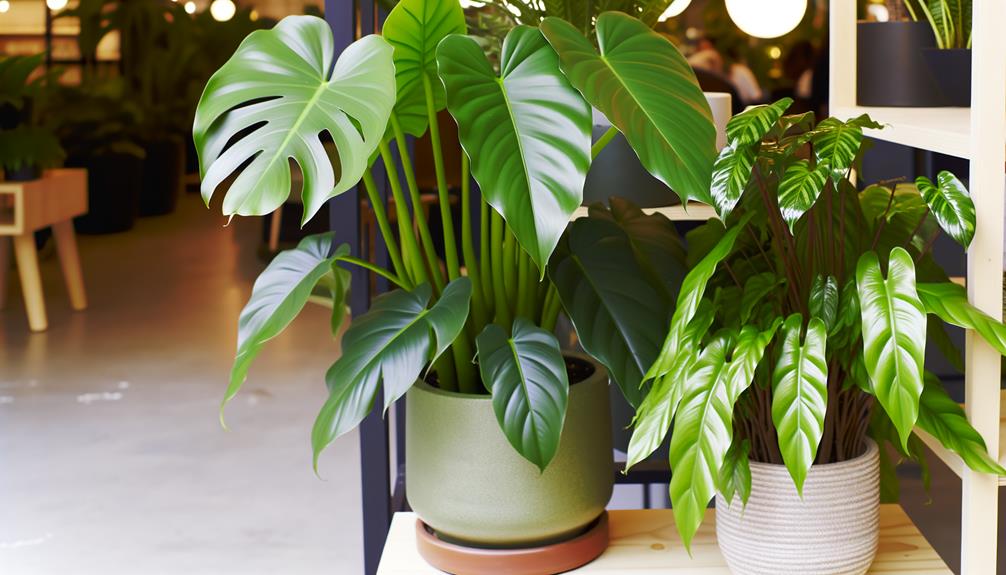
Key Takeaways
- Little Hope has compact, lobed leaves, while Xanadu features broader, deeply dissected foliage.
- Little Hope is suitable for smaller spaces, whereas Xanadu spreads more broadly for larger areas.
- Little Hope’s vibrant green leaves are glossy and flexible; Xanadu’s darker leaves have a matte, rigid texture.
- Little Hope has compact, fibrous roots ideal for confined spaces; Xanadu has expansive, rhizomatous roots for better anchorage.
- Both thrive in bright, indirect light but Little Hope adapts well indoors, while Xanadu benefits from consistent outdoor light exposure.
Characteristic of Philodendron Little Hope vs Xanadu
| Characteristic | Philodendron Little Hope | Philodendron Xanadu |
|---|---|---|
| Leaf Shape | Deeply lobed, delicate, heart-shaped leaves. | Lobed, more structured leaves with a symmetrical shape. |
| Size | Compact plant, typically grows 1-2 feet tall. | Slightly larger, grows around 2-4 feet tall. |
| Growth Habit | Bushy and compact, with a more spreading form. | Upright, clumping habit, more structured. |
| Leaf Texture | Glossy and delicate, softer to the touch. | Smoother, firmer texture with well-defined lobes. |
| Light Requirements | Tolerates low to medium indirect light. | Prefers bright, indirect light but can adapt to lower light. |
| Care Difficulty | Low-maintenance and very easy to care for. | Similarly easy to care for, thrives with minimal effort. |
| Native Region | Originates from tropical regions in Central and South America. | Native to Brazil, commonly cultivated as an ornamental houseplant. |
Origin and History
The origin and history of Philodendron Little Hope and Philodendron Xanadu trace back to the tropical forests of South America, where they were first discovered and later cultivated for ornamental purposes. These species belong to the Araceae family, renowned for its diverse and aesthetically pleasing foliage.
Philodendron Little Hope, a cultivar of Philodendron bipinnatifidum, was selectively bred for its compact growth habit. Philodendron Xanadu, scientifically named Thaumatophyllum xanadu, is a naturally occurring species that gained popularity due to its distinctive leaf structure and manageable size.
Both plants have undergone extensive hybridization and selection to enhance their ornamental value, making them popular choices in horticulture. Their adaptability and ease of care further contribute to their widespread cultivation.
Appearance and Foliage
The Philodendron Little Hope and Xanadu exhibit distinct morphological characteristics in their foliage. Little Hope features smaller, more rounded leaves with a lighter green hue and softer texture, while Xanadu showcases larger, deeply lobed leaves with a darker green coloration and firmer texture.
These differences in leaf shape, color, and texture are critical for accurate species identification and understanding their aesthetic contributions to horticultural design.
Leaf Shape Differences
Philodendron Little Hope displays more compact, lobed leaves, whereas Xanadu features broader, deeply dissected foliage.
The Little Hope’s leaves are characterized by their smaller size and rounded lobes that contribute to a dense, bushy appearance. Each leaf typically has multiple lobes that are less pronounced, giving it a more cohesive form.
In contrast, the Xanadu’s leaves are larger and intricately segmented, with deep incisions that create a feather-like or pinnate pattern. This distinctive dissection results in a more open and airy foliage structure.
The difference in leaf morphology not only influences the overall aesthetic but also affects the plant’s light absorption and transpiration rates, which are pivotal for their respective growth habits and environmental adaptations.
Color and Texture
How do the color and texture of the foliage distinguish Philodendron Little Hope from Xanadu in their visual and physiological characteristics?
Philodendron Little Hope exhibits a vibrant green hue, with leaves that possess a glossy texture, enhancing light reflection and visual appeal. The foliage is softer and more flexible, indicating a higher moisture content.
In contrast, Philodendron Xanadu features a darker, more muted green, with a matte finish that minimizes light reflection. Its leaves are firmer and more rigid, suggesting robust structural integrity.
The textural differences imply distinct adaptations; Little Hope’s glossy leaves may reduce water loss, whereas Xanadu’s rigidity provides increased resistance to mechanical damage. These variations underscore the unique adaptive strategies within the Philodendron genus.
Growth Habits
When examining the growth habits of Philodendron Little Hope and Xanadu, notable distinctions emerge in their upright growth patterns, leaf size differences, and root system characteristics. Philodendron Little Hope exhibits a more compact and bushy growth habit, whereas Xanadu demonstrates a broader, more expansive spread.
Additionally, these species exhibit variations in their leaf morphology and root structure, which influence their overall growth dynamics and adaptability to various environments.
Upright Growth Patterns
Characterized by their distinct growth habits, Philodendron Little Hope and Xanadu exhibit unique upright growth patterns that differentiate them from other species in the Araceae family. These patterns are pivotal in understanding their overall morphology and horticultural value.
- Philodendron Little Hope: This cultivar tends to form a compact, bush-like structure, with upright stems that support dense foliage.
- Philodendron Xanadu: Known for its more expansive growth, it produces a broader, upward-spreading canopy with stems that maintain an erect stance yet allow lateral spread.
- Growth Habit Comparison: While both species exhibit upright growth, Little Hope is more compact, making it suitable for smaller spaces, whereas Xanadu’s wider spread is ideal for larger areas.
Such characteristics are central in selecting the appropriate species for specific horticultural settings.
Leaf Size Differences
Philodendron Little Hope and Xanadu exhibit notable differences in leaf size, which greatly influence their overall aesthetic and suitability for various horticultural applications.
Philodendron Little Hope typically features smaller, more compact leaves, which are deeply lobed and reach an average length of 6-8 inches. This smaller leaf size makes it ideal for indoor settings where space is a constraint.
In contrast, Philodendron Xanadu presents larger, more expansive leaves that can grow up to 18 inches long, contributing to a more dramatic, lush appearance. The larger leaf size of Xanadu is advantageous in creating visual impact in both indoor and outdoor landscapes.
These differences in leaf dimensions are pivotal in determining the appropriate environmental context and care requirements for each species.
Root System Characteristics
The root system characteristics of Philodendron Little Hope and Xanadu exhibit distinct growth habits that influence their overall stability and adaptability in various environments.
Philodendron Little Hope tends to develop a more compact and fibrous root system, which allows for efficient nutrient absorption in confined spaces.
In contrast, Philodendron Xanadu features a more expansive, rhizomatous root structure, promoting robust anchorage and enhanced growth in larger areas.
These differences reflect their respective ecological adaptations and cultivation requirements.
Key distinctions include:
- Root Density: Little Hope has denser, fibrous roots, while Xanadu possesses thicker, rhizomatous roots.
- Growth Pattern: Little Hope’s roots grow in a more confined manner, whereas Xanadu’s roots spread extensively.
- Environmental Adaptability: Little Hope thrives in restricted spaces; Xanadu excels in spacious environments.
Light Requirements
Both Philodendron Little Hope and Xanadu thrive in bright, indirect light conditions, although they can tolerate lower light levels.
Best photosynthetic activity in these species occurs under filtered sunlight, which prevents leaf scorch and promotes robust growth.
Philodendron Little Hope, with its compact form, adapts well to indoor environments where light intensity varies.
Xanadu, characterized by its wider spread, benefits from consistent light exposure to maintain its lush foliage.
Insufficient light can lead to etiolation, where plants exhibit elongated stems and sparse foliage. Conversely, excessive direct sunlight can cause chlorosis and necrosis.
Utilizing diffused light sources or positioning near east-facing windows is recommended to balance light intensity, ensuring these philodendrons maintain their aesthetic and physiological health.
Watering Needs
While ideal light conditions are fundamental for the photosynthetic efficacy of Philodendron Little Hope and Xanadu, their watering needs also demand careful attention to promote healthy growth and prevent root-related issues.
Both species prefer consistently moist, but not waterlogged, soil conditions. Overwatering can lead to root rot, a common affliction for these tropical plants. Key guidelines for proper watering are as follows:
- Frequency: Water when the top 1-2 inches of soil feel dry to the touch, approximately once a week.
- Volume: Ensure thorough watering until excess water drains out from the bottom to avoid salt build-up.
- Seasonal Adjustment: Reduce watering frequency during the winter months when growth rate slows and evaporation decreases.
Adhering to these practices will guarantee optimal hydration for both Philodendron varieties.
Soil and Fertilization
Perfect soil composition and exact fertilization practices are essential for the strong growth and overall health of Philodendron Little Hope and Xanadu. Both species flourish in well-aerated, slightly acidic to neutral soil with pH levels ranging from 5.5 to 7.0. A balanced mix of peat, perlite, and pine bark ensures ideal drainage and aeration, preventing root rot.
Fertilization should be performed bi-monthly during the growing season with a balanced, water-soluble fertilizer (20-20-20 NPK). Organic alternatives, such as worm castings or compost, can also provide necessary nutrients. Avoid over-fertilization to prevent nutrient burn, which can lead to foliage discoloration and stunted growth.
Precise soil and fertilization management enhance the health and aesthetic appeal of these Philodendron varieties.
Common Pests and Diseases
In addition to precise soil and fertilization management, understanding and addressing common pests and diseases is necessary for maintaining the health of Philodendron Little Hope and Xanadu. Both species are susceptible to several biotic stressors that can greatly impact their growth and vitality.
- Spider Mites: These arachnids can cause stippling and yellowing of leaves. Regular inspections and miticides can help mitigate infestations.
- Root Rot: Overwatering can lead to fungal infections such as Phytophthora, which causes root decay. Ensuring well-drained soil and proper watering practices is essential.
- Mealybugs: These pests secrete a sticky residue and cause leaf deformation. Systemic insecticides or neem oil applications are effective control measures.
Proactive monitoring and early intervention are key to preserving plant health.
Conclusion
To sum up, the philodendron ‘Little Hope’ and ‘Xanadu‘ display unique traits that cater to varied horticultural preferences. With individual origins, leaf structures, and growth patterns, each plant requires specific light, water, and soil conditions.
The variations in their care routines and vulnerability to pests highlight the significance of customized horticultural practices. Therefore, grasping these distinctions is crucial for the best cultivation, guaranteeing each plant flourishes in its specific setting like a symphony achieving harmonious equilibrium.

